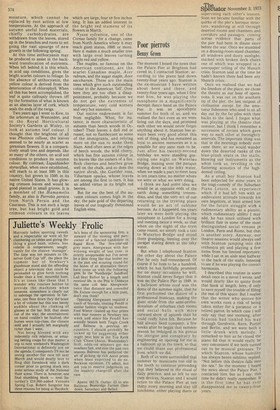Gardening
Autumn leaf colour
Denis Wood
Evergreens have their uses, and some of them also — pines, ilexes and cedars — their majesty and charm, but they all lack the overwhelming advantage of deciduous trees, variety. Strict, bare outlines against a freezing winter sky, fresh tender green in spring, and a blazing autumn downfall.
The colouring and fall of the leaf is a deliberate process undertaken to stop transpiration and loss of moisture, which cannot be replaced by root action at low temperatures. At the approach of autumn useful food materials, chiefly carbohydrates, are withdrawn from the leaves, stored up in the branches and roots to set going the vast upsurge of new growth in the following spring.
At this time anthocyanin may be produced to assist in the backward transtocation of nutrients. When left behind it is this which, in acid sap conditions, gives the bright scarlet colours to foliage. In the absence of anthocyanin, the yellow colour is derived from the deterioration of chlorophyll. When all this has been accomplished, the leaf is quite callously thrown off by the formation of what is known as an absciss layer of cork, which seals the ends of the twigs.
Two years ago I went to Kew, to the arboretum at Westonbirt, and to the Royal Horticultural Society's Gardens at Wisley, to look at autumn leaf colour. I thought that the brightest of all was Photinia villosa, the leaves seemed to be nearly as scarlet as geranium flowers. It is a comparatively small tree and depends, like so many of the others, on acid soil conditions to produce its autumn colour. By contrast, Liquidamber styraciflua, when once established, will reach to at least 50ft in this country, but grows to 150ft in its native United States. It has glowing crimson leaves and would be good planted in small groves. It is a member of the Hampmelis family, as also is Parrotia persica from North Persia and the Caucasus. This is not such a large tree, but has bright gold and crimson colours in its leaves
which are large, four to five inches long. It has an added interest in the bright red stamens of its flowers in March.
Nyssa sylvatica, one of the Cornus family for a change, came from North America wher,e it may reach giant status, 100ft or more. Here it makes a much smaller tree with large oval leaves turning bright red and yellow.
The maples, so famous on the American continent, are the scarlet Canadian maple, Acer rubrum, and the sugar maple, Acer saccharum. These are the main trees which give such outstanding colour to the American 'fall'. Over here they are too often a disappointment, probably because we do not get the extremes of temperature, very cold winters and very 'hot summers. Our native endowment is far from negligible. What, for instance, is more characteristic of autumn than beech woods in October? Their leaves a dull red or russet, not so flamboyant as some of the immigrants, and relying more on the sun to make them blaze. Amd often seen at the edges of beech woods, the wild cherry, which has fine autumn colour in its leaves like the embers of a fire. Both cherries and beeches grow well on the chalk, and so does the native shrub, the Guelder rose, Viburnum opulus, whose leaves are among the first to turn. It has an added virtue in its bright red berries.
But for me the best of the autumn colours comes high in the sky, the pale gold of the departing leaves of our tragically threatened English elms.



































 Previous page
Previous page